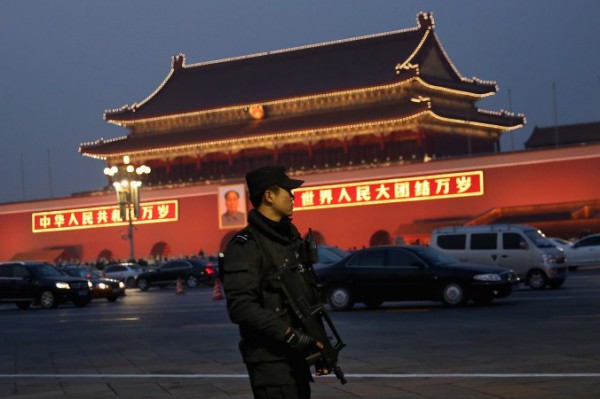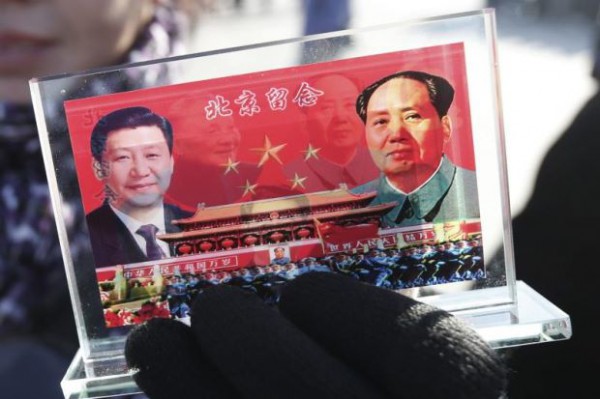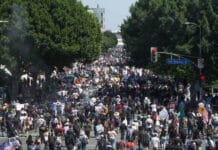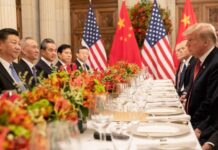Xi Jinping’s shift from dictatorship-by-committee to new ‘paramount leader’ is a high-risk strategy
Editorial statement from chinaworker.info
“More market, less freedom, and much more power to Xi Jinping” – this was the verdict of Beijing-based journalist Ola Wong, on the decisions of the recently concluded third plenary meeting of the CCP’s 18th Central Committee. Third Plenum meetings have a special status in China’s authoritarian system, because of the key 1978 meeting (11th Central Committee’s Third Plenum), which sealed the triumph of Deng Xiaoping over Mao Zedong’s designated heir Hua Guofeng and launched the Chinese Communist Party (CCP) onto the path of pro-capitalist “reform and opening”. Expectations among the capitalists in China and globally have accordingly been high.
Since Xi Jinping and the current CCP leadership were installed a year ago, they have staked enormous political prestige on their commitment to achieving ‘painful’ and ‘urgent’ economic reforms (CCP-speak for neo-liberal capitalist policies). Their aim is to rebalance the world’s second largest economy by raising domestic consumption. This shift is forced upon them by a combination of factors that signal the exhaustion of the current high-investment growth model – above all because of the potentially disastrous debt crisis this has created. Xiao Gang, the chairman of China’s banking watchdog CSRC, recently divulged an incredible statistic: In 64 years of CCP rule, China’s banks have issued a total of 70 trillion yuan (11.5 trillion US dollars) worth of loans, of which 40 trillion yuan (6.6 trillion US dollars) was extended in the past four years. Unofficial shadow banking entities have issued loans for a further 20 trillion yuan (3.3 trillion US dollars), Xiao pointed out. China’s credit machine is out of control in other words, and is also producing smaller and smaller returns. According to Morgan Stanley, five years ago it took one yuan of credit to generate one yuan of gross domestic product (GDP), but nowadays it costs four yuan of credit to create a yuan of GDP.
While promoting market liberalisation, the new leaders and especially Xi Jinping have dispelled any speculation that they might relax the state’s political controls. Far from it, Xi’s first year in power has seen a sharpening of media censorship and state repression against regime critics, outspoken bloggers, and national minorities such as the Tibetans and Uighurs. Xi Jinping’s mission is to reform and refine the CCP’s dictatorial ‘state capitalist’ model, to better serve the new super-rich elite, rather than to abolish it. Accordingly, he has ruled out “Western” democratic reforms and taken measures to increase the dictatorship’s powers. While it cannot be ruled out that Xi may later ease repression and possibly make some peripheral concessions such as releasing some dissidents, on the core issue of maintaining one-party dictatorship his stance is clear. “For sure, Xi will not be China’s Gorbachev,” noted China expert Robert Lawrence Kuhn referring to the last leader of the USSR. As socialists have repeatedly stressed in contradistinction to the liberal political reform camp with their endless illusions, only mass struggle from below can achieve democratic change, not doomed appeals to the CCP tiger to change its stripes.
Markets happy
While initially liberal and capitalist commentators were dissatisfied with the outcome of the plenum and its “lack of specifics”, their mood improved dramatically once the regime published a more detailed reform blueprint. Some commentators speculate the release of this document (on Friday 15 November, three days after the plenum closed) outlining some 60 specific proposals was done deliberately to reverse the negative reaction on financial markets. The 20,000-word document, dubbed by the media as “reform 2.0,” included key phrases such as “The core issue is to handle the relationship between government and the market” and “vigorously develop a mixed-ownership economy.” The reaction to this from China’s left-wing circles expressed in a flood of internet comments from socialists, Maoists and other anti-capitalist layers, is rightly very negative. A word search of the document is highly instructive: “communist” is used zero times, “workers/working class” zero times, “market” appears 80 times. The credit rating agency Moody’s said the change in the CCP’s language was “symbolic of a deeper shift in China’s governance philosophy.”
Global capitalism is clearly impressed. This is shown by big gains on the stock markets in Shanghai, Hong Kong, and across Asia. The World Bank’s President Jim Yong Kim hailed the plenum’s proposals as “extremely positive,” while Bloomberg said the meeting “went way beyond most expectations.” The Economist called the plenum document, “the most striking plans for reform in two decades.” In the view of Arthur Kroeber, writing for the US think tank Brookings, “the reform program reveals Xi Jinping as a leader far more powerful and visionary than his predecessor Hu Jintao.”
Before we look at the specific policy proposals to come out of the meeting and discuss how likely or not is their actual implementation, we must first realise these are not the most significant outcome of the plenum meeting. They are overshadowed by the shift of power within the regime that the plenum signifies, concentrating much more power in the hands of Xi Jinping and, at least in outline, reining in the powers of local governments. Specifically, this concerns the setting up of two new bodies that could mark a decisive departure from the past.
First is the ‘leading group for overall reform’ tasked with overseeing what the state-run China Daily described as “the revolution of reform.” Second is the establishment of a ‘state security commission’ modelled on the US National Security Council, citing rising tensions with Japan (the Japanese government had only recently discussed setting up a similar committee) and increased threat of terrorist attacks, pointing to October’s Tiananmen Square suicide attack. While the exact make-up and leadership of the new bodies is yet to be announced, they will ultimately be under Xi’s control, allowing him to override existing government bodies and structures. These new committees focus on two key elements of Xi’s governance agenda: increased nationalism playing on perceived threats from “anti-China forces,” and his desire to push forward neo-liberal economic reforms in the face of resistance at different levels of the state, especially in the regions.
With this development, Xi is departing from the practice of the past 20 to 30 years and attempting to re-centralise, by transferring key areas of control from the regions, where most economic policies are actually enacted, back to the central CCP leadership. Within this recentralisation, a key element is the concentration of ever greater powers in Xi’s own hands. “Put all this together and it indicates that Xi Jinping now controls the military, the police, public security, discipline [i.e. anti-corruption], foreign affairs and the economy,” noted Oliver Barron of Forbes magazine. “This means that Xi Jinping has now consolidated all relevant power bases in China, drawing parallels to former Chinese leaders Deng Xiaoping and Mao Zedong, as well as his Russian counterpart, Vladimir Putin.” [Forbes Asia, 13 November 2013]
Bonapartism
This represents a major power shift within the Chinese state, a process that began with the intense power struggle leading up to last year’s 18th CCP Congress, as we have analysed previously on chinaworker.info (see our article What changes can we expect from Xi Jinping? ) The congress concentrated more power in Xi’s hands, producing a smaller Politburo Standing Committee, while also shifting representatives of the princelings (the heirs of former CCP leaders), including Xi himself, into key positions. Xi has set about consolidating his position by balancing between the different power blocs and factions within the CCP. One factor, which he has exploited to his advantage, is the fear within all factions of ‘mutually assured destruction’ and the collapse of the state if the internal power struggle is allowed to rage unchecked.
This shifting balance of power is now further confirmed by the outcome of the Third Plenum. Xi is breaking from the ‘collective leadership’ model of his predecessors and attempting to impose a more personal Bonapartist style of rule. “Mr Xi is trying to short circuit a system that has been corroded by perverse incentives and rampant corruption,” commented Jamil Anderlini, the Beijing bureau chief of the Financial Times. This path is fraught with political dangers, however, underlining the seriousness of the internal crisis within the Chinese state and regime. As we explained on chinaworker.info in 2011, describing the previous internal status quo:
“China manifests a peculiar form of ‘Bonapartism’ – by committee, rather than in the person of a ‘strongman’. This too is not accidental. The experience of Mao’s rule and also Deng Xiaoping’s, with erratic swings and accompanying social upheavals, produced the current ‘compromise’ system, in which the powers of the leading group are subject to ‘checks and balances’, realised through an exhaustive process of negotiations and trade-offs between factions, provincial governments and business-based clans.” [China: Repression or ‘reform’? 11 July 2011]
This collective leadership model reached its highest expression during the Hu Jintao era, 2002-12, characterised by Hu’s cautious style. But Hu is now regarded as a weak, indecisive leader, and his rule is scornfully known as the “lost decade”. During this time the CCP-state suffered a form of political ‘gridlock’ – not completely unlike the notorious dysfunction of Washington’s institutions, but of course with ‘Chinese characteristics’. The Hu years are also seen by the economic reform camp, which includes Xi and the new CCP leaders, as a period when the pro-capitalist ‘structural adjustment’ agenda slowed and even went into reverse. Xi wants to break this stalemate by concentrating more power at the centre, to crack the whip over recalcitrant regions, unilateralist economic sectors, and so-called ‘vested interests’ that are seen as blocking reform. Whether this can be achieved remains to be seen. When capitalist economists predict a “bumpy ride” for China’s economic reform programme they focus on the economic headwinds (such as slower growth, rising defaults, and factory closures), but inter-regional tensions and conflicts with the centre will also become more intense.
As we have explained, Xi’s anti-corruption campaign, targeting some top ‘tigers’ and not only low-level ‘flies’, is part of this political strategy to impose greater discipline on an increasingly anarchic and unwieldy governmental apparatus. Similarly, his pseudo-Maoist ‘mass line’ and ‘self criticism sessions’ for regional leaderships (described as ‘self-praise sessions’ by astute bloggers) are aimed at reasserting the centre’s control. Xi has spoken of “putting power in a cage.” A few Maoist rituals are being revived, but crucially these avoid Mao’s habit of leaning on the masses to go around the state bureaucracy when this suited him. Xi’s aim is to strengthen the party-state’s monopoly over politics, and to this end he is clamping down on possible challenges, for example by jailing independent anti-corruption campaigners and ‘whistleblowers.’
Beijing versus the regions
“China is mostly run by the Mayors,” a top Chinese banker explained, referring to provincial, city and local CCP leaders. The vast majority of decisions on industrial development and infrastructure are taken in the regions. This is a key factor behind the rapid GDP growth of the past decades, but has also fuelled monumental corruption and a debt crisis that could ultimately lead to a banking meltdown and threaten the CCP’s rule.
Unprecedented levels of industrial overcapacity are also tied to the refusal of regions to follow orders to close unnecessary or inefficient plants. Widespread economic protectionism exists between provinces and regions, which prioritise and protect their own industries rather than submitting to national decisions. When Bo Xilai was in charge of Chongqing, all the local organs of state power such as the police, courts and propaganda department, were answerable to him, and were even used to bug the phone calls of national leaders. It was this development of a semi-autonomous power base, recalling China’s warlord past, and his refusal to toe the central government’s line, which landed Bo a life sentence, as a warning to other provincial leaders not to challenge the centre. Here there are some parallels with what Xi is now doing and the crackdown on Russian oligarchs launched in the early years of Vladimir Putin’s rule.
There is no originality in the policies of Xi Jinping. His first year in office shows a pattern of recycling the policies and methods of previous leaders (even borrowing a few tricks from Bo Xilai). This is the case with his tributes to Mao, which do not contain an iota of ‘leftism’. This pseudo-Maoism is about defending the system of one-party rule against calls for change. In a speech earlier this year Xi declared, “to completely negate Mao Zedong would lead to the demise of the Chinese Communist Party and to great chaos in China.” More than Mao, Xi has borrowed from Deng Xiaoping who combined a decisive turn to capitalist polices with a steadfast defence of dictatorial rule. “China’s President Xi Jinping is assuming the mantle of Deng Xiaoping, who oversaw both huge economic changes and the Tiananmen crackdown,” commented the South China Morning Post.
Xi has even recently been compared to another princeling, Chiang Ching-kuo, the son and successor to Chiang Kai-shek. But whereas Chiang the younger presided over a dismantling of the Kuomintang dictatorship in Taiwan, this is not Xi’s agenda. Chiang Ching-kuo did however launch a campaign to bring down corrupt ‘tigers’ in the final years of Kuomintang rule in China. This campaign was abandoned on the orders of his father, and as we know that regime could not be saved.
The tug-of-war between the centre and regions is a key factor behind the setting up of the special ‘leading group’ on economic reform. This is clearly intended to bypass the National Development and Reform Commission (NDRC), China’s main planning body, which is seen as being too beholden to local government interests. For years, liberals have criticised the NDRC as an obstacle to economic reform.
Through the new committee Xi seems to want authorship of the main economic reform measures, effectively demoting Premier Li Keqiang, who formally is the leading official in charge of economic policy. Li is officially number two in the CCP’s hierarchy, and the leading representative of Hu Jintao’s non-princeling tuanpai faction. Significantly, the official Xinhua report of the plenum’s final document named Xi 21 times, for leading the task force that drafted the document (assisted by Liu Yunshan and Zhang Gaoli), but it did not mention Li Keqiang at all. This has sparked speculation about Li’s fate and a possible power struggle over economic policy between the two senior figures in the regime. Whether or not this is the case remains to be seen. But it is a fact that every previous leadership constellation over the past two decades has contained an influential premier in charge of the economy – Hu had Wen Jiabao, Jiang Zemin had Zhu Rongji, and even Deng in the 1980s delegated much of the economic management to Zhao Ziyang.
Unchartered territory
Xi’s establishment of a state security commission achieves something that former leader Jiang Zemin tried and failed to do, due to resistance especially from the military. The new commission’s aim is to unify and better coordinate what today is a fragmented system by bringing defence, intelligence, diplomacy and internal security under one roof. This also shows the CCP leadership is preparing for the twin scenarios of war and revolution. The commission will include sub-groups overseeing Tibet and Xinjiang, where a state of de facto martial law has existed for the past 4 to 5 years, as well as Taiwan and Hong Kong, where the CCP is also preparing for major confrontation. Above all, the threat of workers’ and peasants’ struggles developing from localised protests into a nationwide challenge is the regime’s biggest fear.
Many commentators are now judging Xi the ‘strongest leader’ since Deng. “China has not seen a leader who has allocated so much power to himself since Deng Xiaoping,” said Hong Kong-based liberal commentator Willy Lam. “We are seeing a departure from the collective leadership under Hu and Jiang and a return to the strongman politics under Deng. In fact, Xi is looking like a really power-hungry person.”
But Xi’s ‘strength’ has yet to be tested outside the elitist power structures of the CCP. This process shows that the Chinese regime and economy have entered unchartered territory. The cautious approach that characterised the Hu era has given way to Xi’s “bold measures” – but these involve high risks and a much bigger possibility of reversals that can shake the regime and it’s leader’s authority.
As we have explained, the economic reform ‘cure’ could prove worse than the ‘disease’. Accelerated financial reform heightens the risk, as the June liquidity crisis showed, of the very banking failures the regime hopes to forestall. Other aspects of the reform plan can also backfire spectacularly. If neo-liberal remedies are the answer, why are the US and European economies in such a deep crisis? The centralisation of power also increases the risks of social explosions – such is the law of all Bonapartist regimes – with new movements of the working class, rural poor and oppressed minorities dovetailing with increasing tensions within the ruling elite and the state. The concentration of personal power within the CCP dictatorship is a symptom of deep crisis, reflecting the build-up of explosive social tensions. The leaders of the regime, haunted by the spectre of regime collapse, and pressured by a faltering economy, are putting their hopes in a ‘strongman’ to deliver them from this crisis. Like the other changes signalled by the plenum this decision could blow up in their faces.
Below we look at some of the specific reform proposals to emerge from the Third Plenum.
Banking sector reform
This is one area that especially delights global capitalism. The plenum agreed to speed up the process whereby interest rates are set by market forces rather than government fiat. With the increased risk that some, especially smaller regional banks, could collapse, there will be a new deposit insurance scheme similar to existing schemes in Western economies. New rules will allow private and foreign-owned banks to play a bigger role in China. The aim is to make the pricing of capital more efficient by using market pressure, ending the era of cheap credit and shrinking the current dangerous debt burden.
But this will translate into less investment, lower economic growth rates, and falling profits as companies, including the major state-owned corporations, pay higher interest rates. The new deposit insurance scheme will replace – in a more restricted form – today’s de facto all-inclusive insurance scheme where savers assume that as the state owns the banks their savings are “safe”. Although this is not spelt out to the general public, the new scheme is therefore a preparatory step, in order to avoid bank runs, to allow a number of heavily exposed smaller banks and shadow entities to collapse as part of an unavoidable banking sector shakeout. In this process the government will concentrate on shoring up the largest “too big to fail” financial institutions. The opening to foreign capital is to allow these investors to pick over the leftovers from this banking sector shakeout.
One-child policy
As we predicted on chinaworker.info, the Third Plenum announced a small relaxation in China’s strict birth control polices. While this may be followed by further relaxation, the current proposals are so limited that the National Population and Family Planning Commission has disputed the use of the term “relaxation”. Couples will be allowed to have a second child if one partner is an only child. This only applies in cities as rural couples can already have a second child if their first-born is a girl. The change affects around 15-20 million women in China, of which around half are thought likely to want a second child. The cost of raising a child in China’s cities, especially school fees and housing costs, is astronomical. A study by Renmin University found that more than 90 percent of rural couples in Jiangsu province favour having only one child. The new rules will be phased in and are likely to start in wealthier eastern regions where the birth rate is lowest.
This measure enables Xi to win some easy popularity – to sugar the pill of an otherwise toxic pro-business reform plan. The economic rationale for a higher birth rate is to stimulate consumption and to correct a demographic trend whereby China’s working age population has begun to fall, from 75.5 percent in 2011 to 74.4 percent in 2012. A shrinking labour force increases the bargaining power of workers, and complicates the reformers’ plans to introduce greater wage competition and increased exploitation. But the effects of the rule change will not be felt for many years. Despite this, when the news was announced there was an immediate rush by speculators into the stocks of Chinese companies making baby formula and diapers.
In a second part of this statement we will look at the proposals for land privatisation, urbanisation, abolition of the laojiao labour camp system and currency controls.





